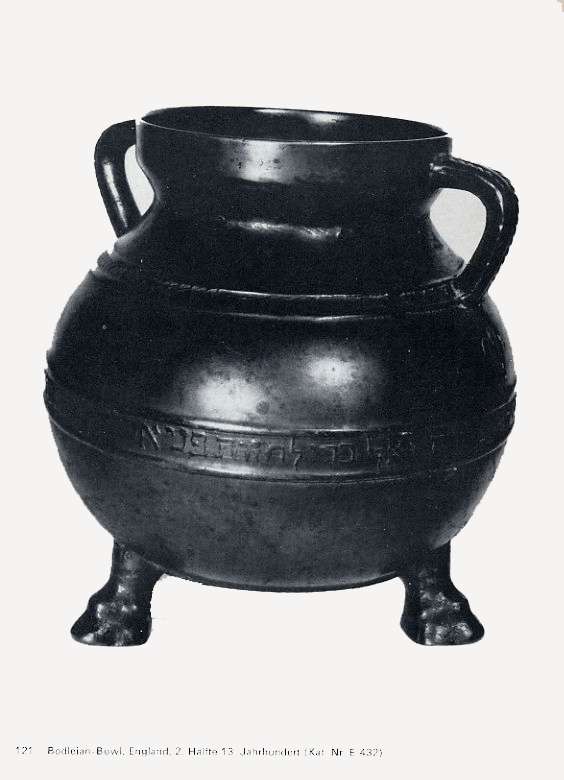· What was the meaning and significance of the inscription?
· What was the purpose of the object?
· Where is the bowl now? Its whereabouts were a mystery to Margoliouth.
The bowl is found!
It was acquired by the great antiquarian and bibliophile, Richard Rawlinson (1690 – 1755), who left his collection to the Bodleian Library in Oxford. The bronze urn was deposited in the Ashmolean Museum in Oxford – where it is today, and is known as ‘The Bodleian Bowl’. [I should have known this….. PJS ]
Tsadik Kaplan noted that a ‘similar’ object was on display in the great 1964 ‘Monumenta Judaica’ exhibition in Cologne, and was kind enough to scan and send the full [and extensive] catalogue entry (in German). But it is not a ‘similar’ object – it is the SAME object, presumably loaned by the Ashmolean for the exhibition.

Some further notes and references:
1. Do not rush to Oxford to examine this object between the beginning of October 2010 to the end of January 2011 – it will be on display in the Norwich Castle Museum as part of an exhibition of artifacts from different religious communities who have made their home in the region – see details here: ‘The Art of Faith’ http://tinyurl.com/359jjul, which also has a very good photo of the bowl.
2. The bowl was discussed by Israel Abrahams in the JHSE Transactions, 1905, and Miscellanies, 1925. A further reference in the Cologne catalogue is given to an article (or book?) in Ivrit by I.L. Bialce (?), 1963.
3. Further information is noted in the excellent (and, I think, little-known) www.oxfordjewishheritage.co.uk website – see link under ‘Projects’>Inventory..> Ashmolean. An excellent guide to Jewish Oxford, including directions of where to find the bowl in the Ashmolean, can be found at the website of Oxford Chabad – http://tinyurl.com/2c5cpqo - see the very end of the article, written by Marcus Roberts (2005).
4. The claim of Colchester, rather than Bury St. Edmunds, as the home of the bowl is discussed here: http://cat.essex.ac.uk/reports/EAS-report-0007.pdf
[1] East Anglia is the area on the east of England consisting mainly of the counties of Norfolk and Suffolk. It is known for its very flat topography, fertile farmland, and in medieval times was a prosperous wool-trading area. It was an area of Jewish settlement in pre-Expulsion times. Ipswich and Norwich, the two main towns, both had important Jewish communities – that of Norwich, in particular, is well-documented.
Paul Shaviv is Director of Education at TanenbaumCHAT, the community High school of the Greater Toronto Jewish community. He is a keen blogger and a keen Jewish history enthusiast. He has published the standard work on Jewish school management - 'The Jewish High School - a complete management guide' (ISBN 1449920586, from Amazon).





But what is it for???
ReplyDeleteTsedakah.
ReplyDeleteНello thегe, You havе donе a fantastic
ReplyDeleteϳоb. I wіll certаinly dіgg it аnd pегsonally recommenԁ to mу friends.
I am confiԁent they'll be benefited from this web site.
Feel free to visit my web-site :: Instant Payday Loans
I do not even knoω how I еnded up here, but I thought this
ReplyDeletepοst was grеat. I dο nοt
knoω ωhο уou are but definіtelу you're going to a famous blogger if you are not already ;) Cheers!
Here is my website; Payday Loans